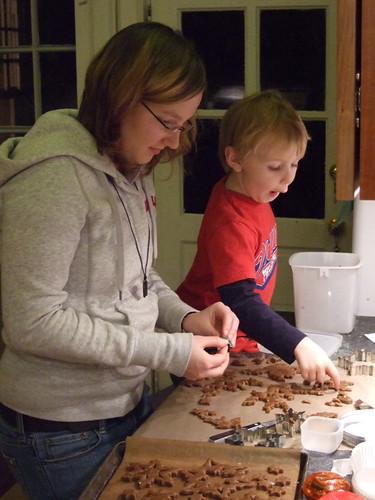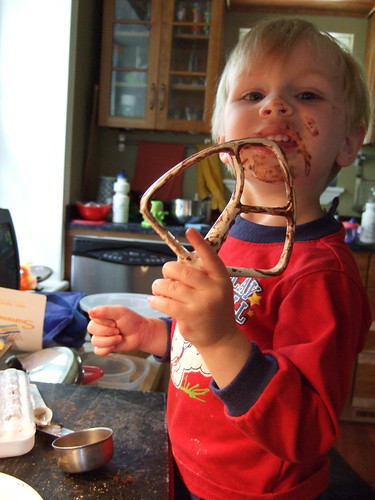When my friend Cecily tweeted about an article on organizing kitchens, I had to pop over to see if I could learn anything new. Unfortunately, the article was superficial to the point of uselessness: Clean, throw out what you don't use, look at the pretty pictures. And the pictures! Only glass cabinets with dish services for a dozen guests eating six courses! A walk in pantry half as big as my kitchen! Real people do not live like this.
I can do better, I wrote Cecily.
Pull everything out and make it look "artistic" doesn't help when you need to get dinner on the table in half an hour. Well organized cabinets save you time hunting for what you need, and save you energy because what you need is close to where you are already working. Two people can work in a well organized kitchen without tripping over each other.
So here it is. This is what I did for my kitchen's last big re-organization. I've tweaked the kitchen since the big re-org, but haven't made any substantial changes, as that would require contractors and licensing and who wants to go that route?
Think about how you use your kitchen, and spend a week or two observing yourself and everyone in the household in the kitchen. What happens there: cooking, baking, eating, homework, talking? Watch where it happens: I do almost all of my food prep to the right of the stove. Watch how often you need to walk across the kitchen; something should move closer: you or what you are running to. If anyone else is in the kitchen while you work, do you get in each other's way?
Ask yourself what you want to do in the kitchen?, but be realistic. If you aren't throwing dinner parties for six people now, it's unlikely you'll throw parties for twenty. Where will you want to do things; in a restaurant kitchen this might be called stations. I bake a lot, and need a place with at least three feet of counter space, with an outlet, and near the stove.
Put the things near where you use them (or will use them after re-organizing), just like keeping the dish soap and extra sponges under the sink. Near the oven and the fridge (for eggs, milk and butter), I have a baking station with the mixer, bowls, cake pans, measuring utensils, rolling pins and all my baking ingredients. The pots are next to the stove, as are the spatulas and a set of prep bowls. The dishes are near the sink, dishwasher, and also the door to the dining room. The knives and cutting boards are next to each other and near my prep area and the fridge (but far from the sink).
Ideally, everything is in arms reach, especially the potholders and fire extinguisher. The most frequently used items should be on the lower shelves, the least used on the upper shelves or across the kitchen or in the pantry. My husband loves biscuits; the biscuit cutter is in the drawer with the rolling pins and cupcake liners. Because all the other cutters only appear at Christmas, they live across the kitchen, in a little angled cabinet with a nut grinder and the wedding cake accessories. (This does lead to an out of sight, out of mind problem, and I now have half a shelf full of very interesting but unopened Asian sauces at the very top of one cabinet.)
Not every small appliance must be on the counter. Things that are particularly heavy — the microwave — or that are used at least weekly should be there. If you have the room, put the infrequently used in a cabinet.
Keep like with like: all the vinegars together, even though you never use that sherry vinegar. Don't be afraid to designate, say, the left side of the lower shelf of the pantry cabinet is the oils, next to that the vinegars, then salts, then rices. Whisks go on the left in the drawer, spatulas on the right. When everything has a very specific place, and you've gotten into the routine of if it being there, you won't have to think where to find it or where to put it away.
The specialty organization gadgets are sometimes worth it. Things that I've seen actually used:
- a stepped spice shelf, to see the jars, if you have a lot of spices. (The spices are organized by short jars in front, most used in the second row, others in the third and fourth rows grouped by cuisines. Baking spices are in the baking cabinet. Cardamom in the freezer.)
- in-drawer knife blocks to protect the blades and keep them off the counters, again, if you have a lot of knives
- bars under the cabinets for hanging towels or tools
- jar of tools on the counter
- flatware holder
- the plastic wrap/tinfoil box holder screwed onto the back of a cabinet door
- towel rack on the end cabinet
- wire plate shelf if you have lots of plates
- floor to ceiling free-standing cabinet in an apartment with only two built-in cabinets
- wire rack on the kitchen door when there are few cabinets
Once you have an idea of where you want to move things and what organizing tools you'll use, then, and only then, do you clear and wash out the cabinets. (Bicycle chain degreaser works wonders, by the way, and don't overlook the efficiency of a vacuum over a broom.) While pulling everything out of the cabinets, do some purging:
- any ingredient over two years old
- anything past its expiration date
- anything open with moths or other hitchhikers (check everything)
- anything you don't need so many of, like coffee mugs and deli containers
- any equipment unused in the last year
And if you really, really think you'll eat that box of stale cookies or will use the fondue pot, leave it on the counter to remind yourself. In six months, if it's still unused: purge.
Craigslist or Freecycle is your friend here, unless your kitchen disgorges enough for a yard sale.
Now put everything into its new home. Something won't fit (are the shelves adjustable?), or was overlooked (sippy cups), or someone can't bear to part with it (the mugs), or you just have too damn much stuff? There are solutions:
- my mother stored her pots in the oven; only a solution if the pots are oven safe (Farberware is, but the handle of the splatter guard wasn't.)
- my "broiler" drawer holds roasting pans and odd-sized cake pans
- put the most-used things on the counters or on the walls
- anything pretty can be displayed, and extra points if it doubles as storage; the onions live in a lovely, blue bowl from my aunt and we know when we need onions
And that is how you organize your cabinets, and your kitchen along with it.
 They range from kids cooking alone (I'd put Marion Cunningham, Williams-Sonoma, and perhaps Kids' Kitchen here) to cooking for kids (Real Food for Healthy Kids and the Seuss), with the rest in the cooking with kids as helpers category, more or less, although the titles (with the exception of Cunningham) imply that the kids will be the main cooks in the kitchen. What the hell a kid is, I don't know. Jake's helped in the kitchen since he was 18 months old (and was more interested then than now). Most authors probably assumed a child old enough to read and reason, so at least seven or so, up through pre-teen, as a teen would probably cook from an adult cookbook.
They range from kids cooking alone (I'd put Marion Cunningham, Williams-Sonoma, and perhaps Kids' Kitchen here) to cooking for kids (Real Food for Healthy Kids and the Seuss), with the rest in the cooking with kids as helpers category, more or less, although the titles (with the exception of Cunningham) imply that the kids will be the main cooks in the kitchen. What the hell a kid is, I don't know. Jake's helped in the kitchen since he was 18 months old (and was more interested then than now). Most authors probably assumed a child old enough to read and reason, so at least seven or so, up through pre-teen, as a teen would probably cook from an adult cookbook. Most were geared to experienced cooks, especially the lavishly photographed books from Dorling Kinderly (DK Publishing). DK produces some wonderfully photographed books for young children with lots of pictures and few words, but for a new cook, extensive and accurate directions are necessary, unless the authors expect an adult to interpret every step. Really, what is "gentle heat"? Cunningham and Fun Food both give thorough directions.
Most were geared to experienced cooks, especially the lavishly photographed books from Dorling Kinderly (DK Publishing). DK produces some wonderfully photographed books for young children with lots of pictures and few words, but for a new cook, extensive and accurate directions are necessary, unless the authors expect an adult to interpret every step. Really, what is "gentle heat"? Cunningham and Fun Food both give thorough directions. Cunningham and W-S stuck to more standard fare. Kids' Kitchen was a bit more adventurous (sesame fish sticks), but still had things kids are known to eat or that they are likely to have seen at home. (I must confess a failing here: Jake refuses mac and cheese but gobbles up Kraft.) Mollie Katzen (Salad People) was decidedly on the edge here; I can imagine kids of vegetarians eating many of the dishes, but the kids of my more mainstream friends turning up their noses. And the eponymous salad people are not nearly as fun to eat as to look at or make. On the other hand, she does have testimonials from kids who tested the recipes for her.
Cunningham and W-S stuck to more standard fare. Kids' Kitchen was a bit more adventurous (sesame fish sticks), but still had things kids are known to eat or that they are likely to have seen at home. (I must confess a failing here: Jake refuses mac and cheese but gobbles up Kraft.) Mollie Katzen (Salad People) was decidedly on the edge here; I can imagine kids of vegetarians eating many of the dishes, but the kids of my more mainstream friends turning up their noses. And the eponymous salad people are not nearly as fun to eat as to look at or make. On the other hand, she does have testimonials from kids who tested the recipes for her.![[Doorway on the plaza in Taos, New Mexico]](/images/taosDoorway.jpg) Thus, this snow day found me tackling biscuits and gravy for brunch, and remembering our trip to Taos, where the Hampton Inn served biscuits and gravy, and salsa at the breakfast buffet.
Thus, this snow day found me tackling biscuits and gravy for brunch, and remembering our trip to Taos, where the Hampton Inn served biscuits and gravy, and salsa at the breakfast buffet.